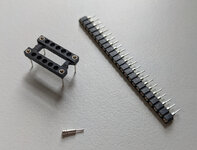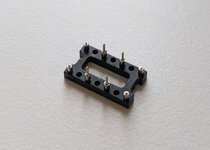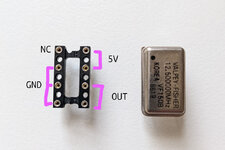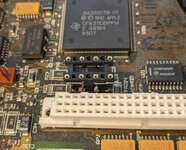Inspired by this thread, I just overclocked my Quadra 650 to 40 MHz.
1. I found it to be consistently slightly faster (1%) with stock ID 36 than resistor-modified ID 51. I assume memory is overclocked 36@40MHz vs 51@40MHz?
2. My Daystar 128K Quad Cache (aka FastCache Quadra) does not work in the overclocked configuration. The Daystar QuadControl v2.3 init hangs at startup. Unlike the IIci cache card, the Quad Cache card is not enabled until the software kicks in.
3. TattleTech 2.84 won't startup in System 7.5.5 when overclocked, but will in 8.1. Perhaps there is a gestalt or system bug in 7.5.5. Something to keep in mind if other programs have issues.
4. If the Quadra 800 is just a Quadra 650 with a vertical LED attacked, why does the Quadra 800 require 60 ns RAM but the Quadra 650 only needs 80 ns RAM? Is the stock Quadra 800 faster than a stock Quadra 650?
Cool! One day I'll come back to my Wombat ventures…one day.
1. That's interesting. I'd have to look back at the System 7.1 decompile files mentioned/referenced earlier in the thread to see what's happening. It was a planned gestalt. We know from the notes in the files there were planned 40 MHz "Frigidaire" (tower) and "Lego" (desktop) versions of the Wombat, but since they weren't produced officially, there may be non-final timings and other settings there. I'm not really qualified to elucidate there.
Maybe a closer look at the Norton SysInfo test scores could bring out some more info as to the ups and downs. There's definitely the problem of the vanilla 040 enabled not having those other gestalt IDs in it, but I couldn't say off the top of my head what those performance vectors could could be.
2. Sounds about right. I don't know where it is, but there should be an 040 cache thread with info, or Bolle might've chimed in earlier in the thread, but I believe the long and short is that the wait state config on the cache cards is definitely made to work with stock Quadras (not sure about the 840av, since it's a completely different beast), so 33 and below is likely the target.
3. Hm. I've actually never used the program on my Macs. I'm trying to recall what system version I was running when I ran TechTool Pro, but I'm sure as others test out software that we'll come across esoteric limitations to the overclock.
4. From a marketing perspective, it's to frame the 800 as a higher-end Quadra. In practice, it's due to the 800's on-board RAM being 60ns; I'd have to look, but I think one of mine is 60 and the other is 70 (one is a Centris, the other I never knew as it came to me bare), but again, it's been a few moons since I worked on them. What's odd is that 80ns seems to be uncommon. My Centris board has 70ns, so IDK. I have a vague recollection of someone saying it was one of the Centris (marketing) configs: lower end versions without AAUI, an LC040, and probably slower DRAM.
The clock speed isn't any different between a higher tier 650 and an 800. Both had 33MHz 040s and never sold any faster. Again, it might've just been marketing fluff: tower vs desktop








